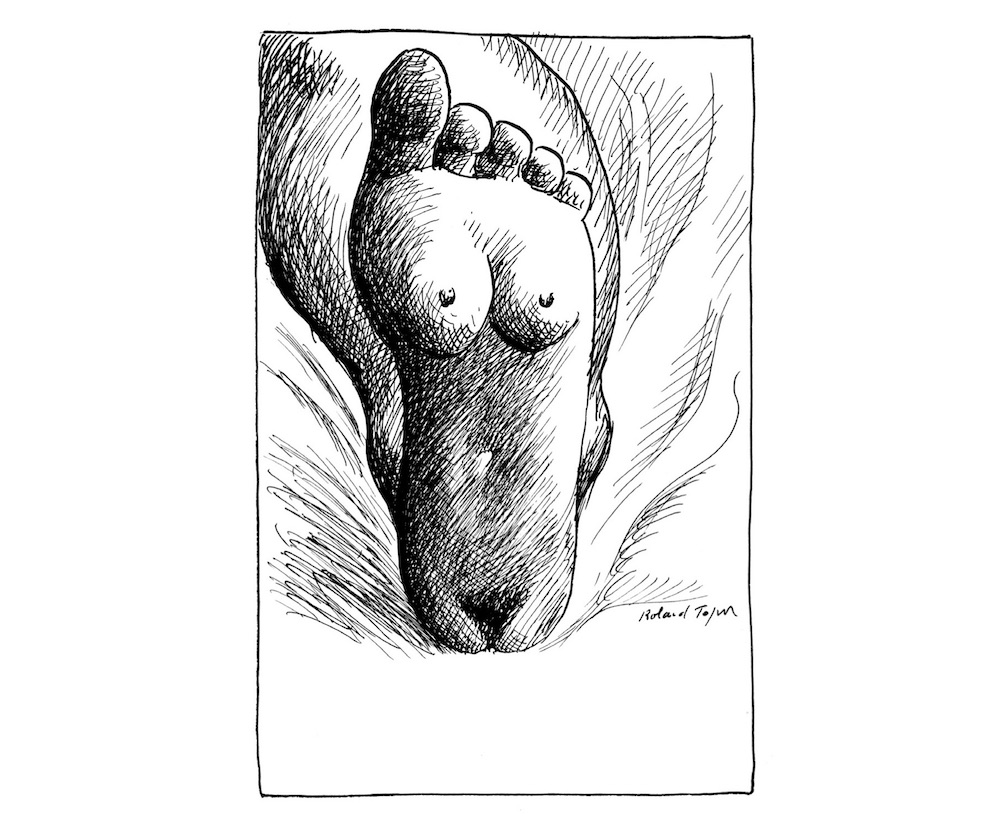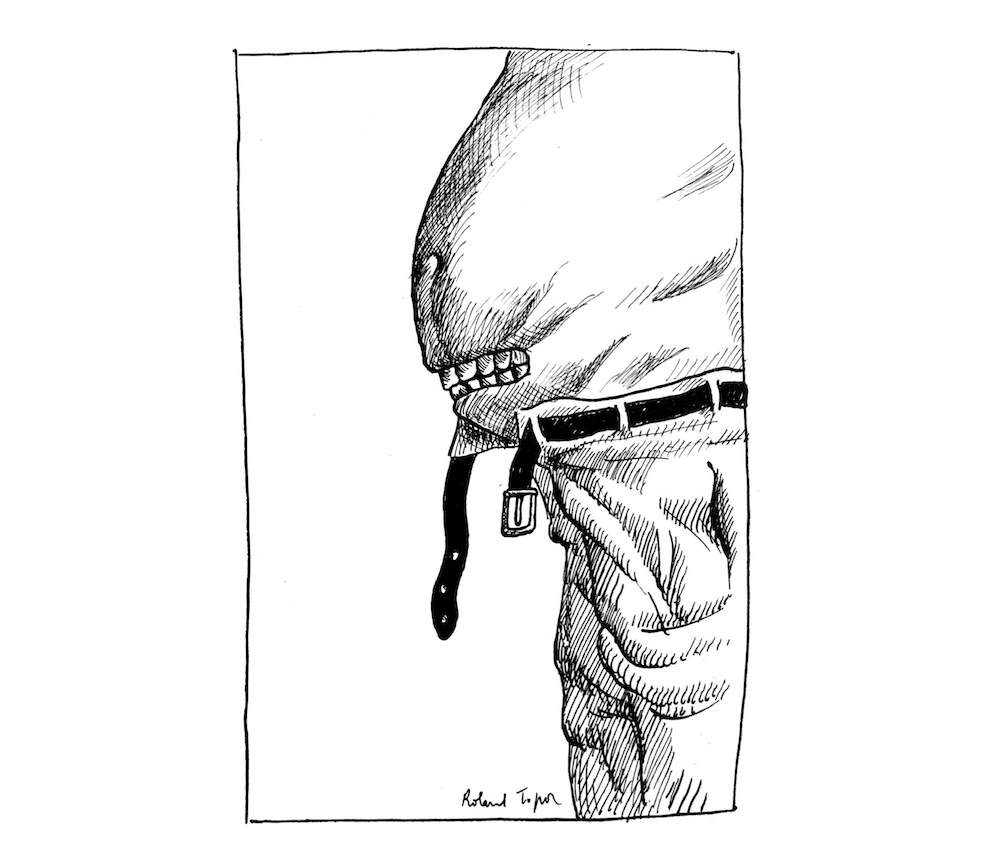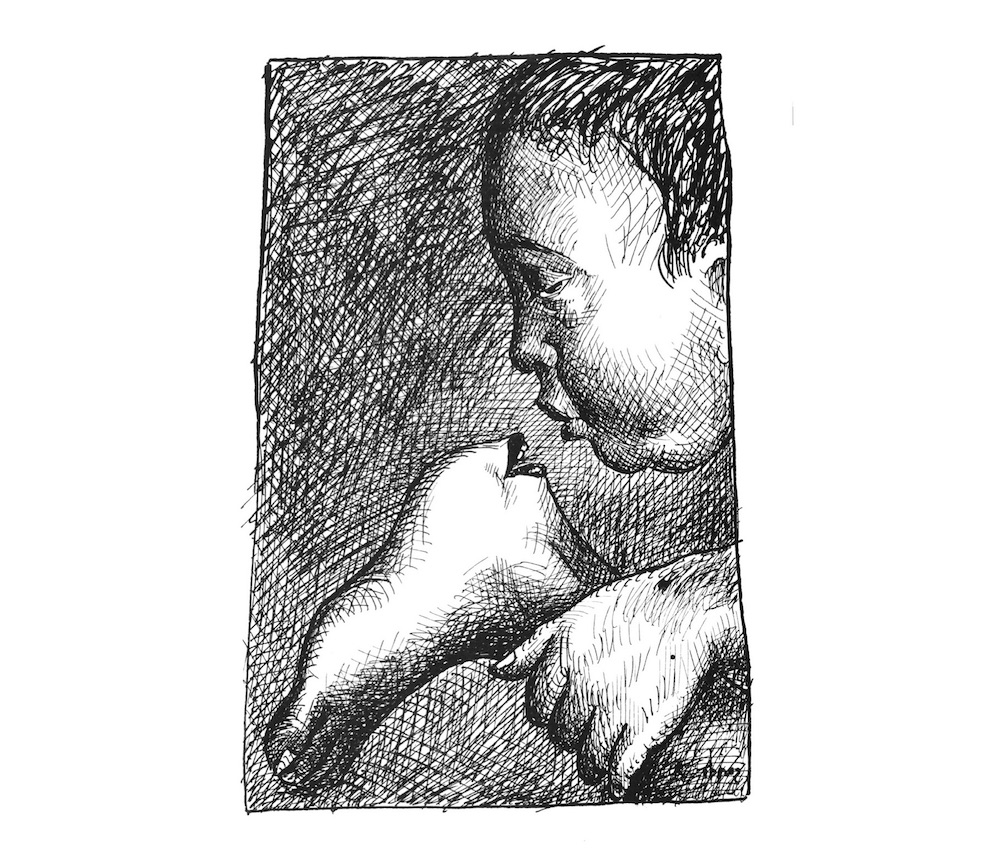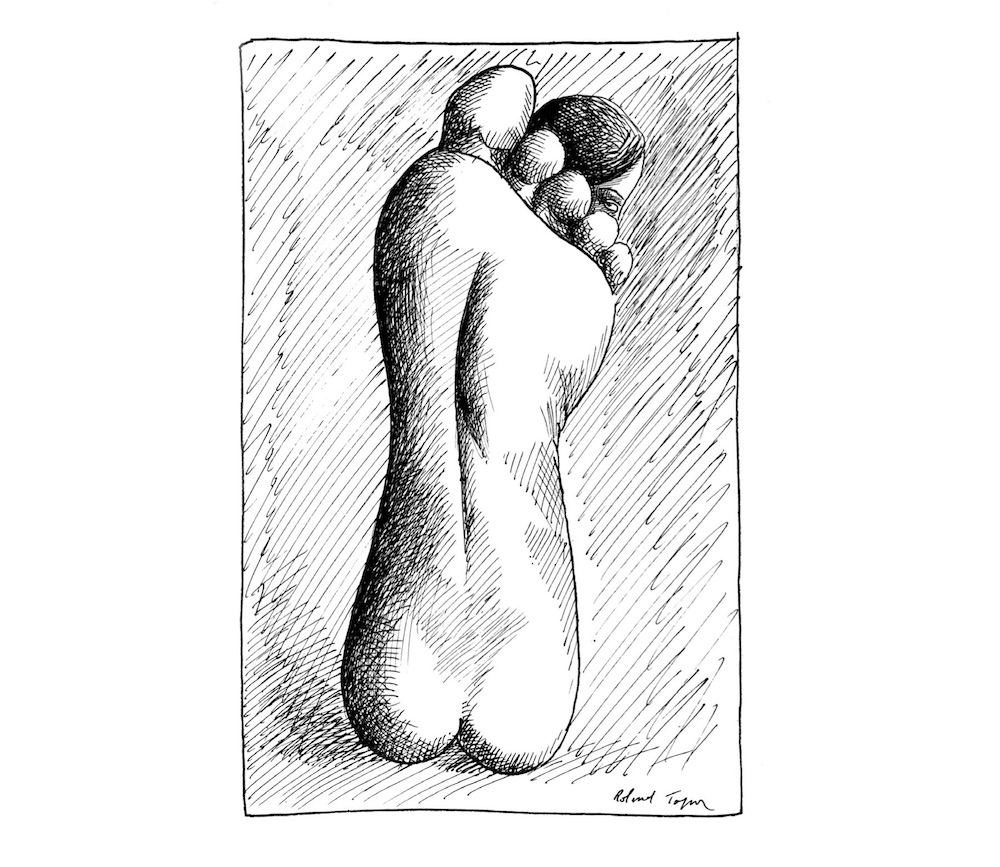While he is best known in his native France as an artist, and perhaps for his turn as Renfield in Werner Herzog’s Nosferatu (1979), Roland Topor’s written works are still generally unacknowledged. In the scant body of critical writing surrounding his books, they are classed as “post-surrealist horror” that demonstrate “the same half-sane magnifications that strike home in Kafka.” And yet to read his novels, short stories, and plays is to enter a world far from the sleek poeticisms of Breton’s Nadja (1928) or indeed the safety of a barricaded room in which Gregor Samsa hides his transformation in The Metamorphosis (1915). Topor’s writing, much like his illustrations, plunges the reader again and again into predicaments in which grotesque metamorphoses are encountered already in advanced states of development and resultant crisis. In this way, the narratives lead us in a sense to the ground where Breton and Kafka leave off.
Unlike these earlier works, Topor’s evocations of dysfunctional social interactions are not a narrative end in themselves, nor can the individual in transformation hide away from social relations, or escape their fate in death, but must continue. In pushing these tropes beyond their established limits, Topor generates a world in which the great unsaid realities of human life are painfully laid bare, amplified through a series of confrontations with “le sang, la merde et le sexe” (“blood, shit and sex”). While few of his texts have been made available in English, they are nevertheless representative of his wider body of work, in which the reader constantly trips over these same themes as if stumbling upon a naked corpse in a darkened room. They predicate an oeuvre of carnivalesque and necrophilic eroticism, and draw out the pungent, animalistic core hidden within the norms of our everyday existence. Topor’s narratives are shot through with macabre irony, orgiastic scatology, and physical and psychological cruelty, which constitutes a fundamental reframing of the characteristics of human interaction with others. According to Alexandre Devaux, Topor “deploys the arguments of an authentic reflection on the human condition. But it’s a reflection where thought travels through mirrors that are both deformed and deforming. Where reason is mutated and put through absurd metamorphoses, exasperating it to the point of insanity.” Within the texts, the reader’s self-reflection is warped via a grotesque sublimation of Stendhal’s conception of literary mimesis, and Devaux’s description is indeed reminiscent of a celebrated Stendhalian image:
A novel is a mirror carried along a high road. At one moment it reflects the azure skies for you to see, at another the dirty puddles at your feet. And the man who carries this mirror with him you will accuse of being immoral! His mirror shows the mire, and you blame the mirror! Better to blame that high road where the puddle was found, or indeed the inspector of roads who allows the water to settle and the puddle to form.
In Topor’s formulation, though, these potholes have not been allowed to form through negligence, but have purposefully been dug out with human hands, and have filled with liquids more viscous than water; they are puddles the reader is able to glance into anew owing to a flexing of the mimetic mirror. The first reaction for most readers when faced with such putrefaction of the self and the body is perhaps one of disgust. And this reaction was not uncommon. Topor’s play Vinci avait raison is a kind of parody of An Inspector Calls (1945), and in the house where it is set and from which no one may leave the toilets are clogged up and excrement gradually forms in mounds about the stage. When the play was read in London at the Arts Theatre Club in 1978, Topor’s English publisher John Calder reported that “not many of the audience waited for the end.” When it was put on at the Théâtre de Poche in Brussels in 1977 the play caused a national scandal. In the Belgian press, the critic Philippe Genaert demanded that the state intervene. “We must put this idiot in prison for creating such filth,” he wrote. “This is a question of the public moral good.”
Five years earlier, in 1972 after the first theatrical performance of Joko fête son anniversaire, Genaert had even gone so far as to call for Topor’s execution: “in some countries, the author would be shot.” This was, however, a reaction Topor had fully expected.
Roland Topor was no stranger to calls for execution in the name of preserving the public’s “moral good.” His parents were Polish Jews who arrived in France in the 1930s, and for this “crime” his father, Abram, was arrested and sent to a prison camp in 1941. Alongside thousands of other Jewish men from Paris’s 10th arrondissement, he had answered the call to register himself as such with the Vichy authorities, and queued up in the Rue Grange-aux-Belles before being herded into a van and transferred to the camp at Pithiviers where he was interned, unaware of arrangements for subsequent transportation eastwards. Even so, Abram sensed that something was horribly wrong, and despite the entreaties of his fellow prisoners he managed to escape from the camp and hid in the southern outskirts of Paris. Of all the inmates who passed through Pithiviers only 159 survived; the other 3,551 were murdered in the concentration camps. After his father’s escape, the Topors’ landlady would ambush Roland and his older sister Hélène on the stairs of their building and try to trick the children into giving away their father’s whereabouts, as Hélène remembered:
“The landlady never missed an opportunity to intercept the Topor children. She would question them with sly cunning:
“Hello, my little children, are you going to see your papa?” — “No!” Hélène replied curtly. Then in a very sweet voice she would ask Roland: “And you, my little boy, are you off to see your papa?” … “Yes, I’m going to see my papa!” — “Oh really? And where is your papa?” — “My father is a little old man,” Roland said proudly.
This was what Hélène had taught him to say when asked the question, and thus the landlady’s deviousness was evaded.
When a neighbor warned the family in May 1941 that the French police, accompanied by the Gestapo, were going to make a sweep of the whole building, they fled along with Abram to Vichy France. Roland was placed with a French family in Savoy, where, like Georges Perec, he lived out his childhood as a Catholic schoolboy under a false name and with an assumed identity, hidden in plain sight.
Unlike Perec, though, whose parents were consumed by the war (his father killed at the Front in 1940, his mother at Auschwitz in 1943), Topor’s family survived. In 1946, his parents sued their old landlady for the restitution of their belongings, and for the right to return to their apartment which had been occupied by an “Aryan” family since their escape. The courts decided in their favor on both counts, and after moving back in they continued to pay rent to, and live above, a woman who had tried her best to have them apprehended and killed. Which brings us back to this quote: “I want my existence to be a supreme affront to the vultures who have become so impatient since the Forties, by way of an uninhibited representation of blood, shit and sex.”
For Topor the hidden nature of these aspects of humanity became emblematic in turn of a wider regime of silence inherent to human living. Had more of his writings been translated into English or remained in print in French, or had they been discussed more widely by critics in either language, they might have been seen as a brutalized, and brutalizing complement to Perec’s work (in both writers there is a continual smudging of the desperate question “Why?” with the horrifying conclusion “Because that’s the way it is”). While Perec’s writings often appear to attempt to eulogize the tenets of a “normal” life taken away from him by the people, society, and culture around him, Topor goes to war with these people, and the society and culture within which he is entombed, in which he has no choice but to participate, and go on living. As Devaux noted, “The psychological motif of the individual attacked and menaced to the point of annihilation by the social organism recurs frequently in Topor.” In the novel for which he is best known, Le Locataire chimérique, Topor’s protagonist Trelkovsky realizes:
Martians—they were all Martians. But they were ashamed of it, and thus tried to conceal it. They had decided, once and for all, that their monstrous disproportions were, in reality, the true proportion, and that their inconceivable ugliness was beauty. They were strangers on this planet, but they refused to admit it. They pretended that they were perfectly at home. He caught a glimpse of his own reflection in a shop window. He was no different. Identical in fact, he looked exactly the same as the monsters. He belonged to their species, but for some unknown reason he had been cast out. They didn’t trust him. All they wanted from him was that he obey their incongruous rules and their ridiculous laws. Ridiculous only to him, because he could never fathom their finer points and subtleties.
The grotesque ghouls that people Trelkovsky’s building and neighborhood drive him into identity dysphoria and a cycle of perpetual suicide, as all the while they feed off his excrement, ergo his humanity—something his Martian neighbors and Martian landlord have lost in their vampiric will to violence. With these themes, Topor’s writing constantly returns to the fever dream of surviving the Holocaust, in which the everyday banality of greeting the landlady on the stairs and a continent-wide genocide flit about one another like flies above a corpse.
Which returns us to the naked body in the darkened room, and perhaps also to the contextual background against which Topor’s Head-to-Toe Portrait of Suzanne (a novel, despite its apparent brevity) should be read. Aside from calls for his execution or imprisonment, Topor assumed at the same time that his writing would find a sympathetic readership somewhere and it is to this audience that he is really addressing his work, with a message that “courage … is the energy you give to being yourself, so as to endure.” As he wrote, developing this point further: “For me, there’s survival and the need to find others like you, and since these people also conceal themselves you have to send out signals. It’s better to be many.
Topor’s aim in writing was not just to appall Genaert and the like, nor those in the audience who walk out, but for the few who stay. In so doing, he wrote that his object was to form a “margin” away from the general “milieu” in order to disrupt his own sense of alienation by alienating the people that would have him killed; to disrupt the alienation of the individual in deathly society by presenting an aesthetic space akin to Bataille’s concept of the unassimilable. In an interview, Topor stated:
If I put a hand in place of a head, some people will say “That’s horrible, how disgusting!” But such a reaction is pathological. By putting the liver where the brain is, and the brain in place of the feet, I don’t feel like I’m trampling on values or contributing to the collapse of society. I seek to enlarge the field of play and speculation a little, by disrupting things that appear too stable, or immutable. Personally, I don’t believe in this stability. We tend all too easily to fix things in permanence.
Head-to-Toe Portrait of Suzanne (Portrait en pied de Suzanne, 1978) is the first of Topor’s written works to be presented to an English-speaking audience in some forty years, and I hope it will not be the last. In its pages, Topor again addresses the horrors of social alienation via his staple themes of “le sang, la merde et le sexe,” and it is these elements that form the touchpoints of a story that here unravels as a whirlwind romance between the lonely narrator and the beautiful Suzanne.
Andrew Hodgson is the translator from the French of Roland Topor’s Head-to-Toe Portrait of Suzanne and from the Danish Carl Julius Salomonsen’s New Forms of Art and Contagious Mental Illness. He is author of the novel Mnemic Symbols and the monograph The Post-War Experimental Novel: British and French Fiction, 1945–1975. He is a teaching and research fellow at Université Paris Est.
Introduction and illustrations from the Atlas Press translation of Roland Topor’s Head-to-Toe Portrait of Suzanne. Text copyright Andrew Hodgson, drawings copyright Nicolas Topor.
from The Paris Review https://ift.tt/2JtHwb1




Comments
Post a Comment